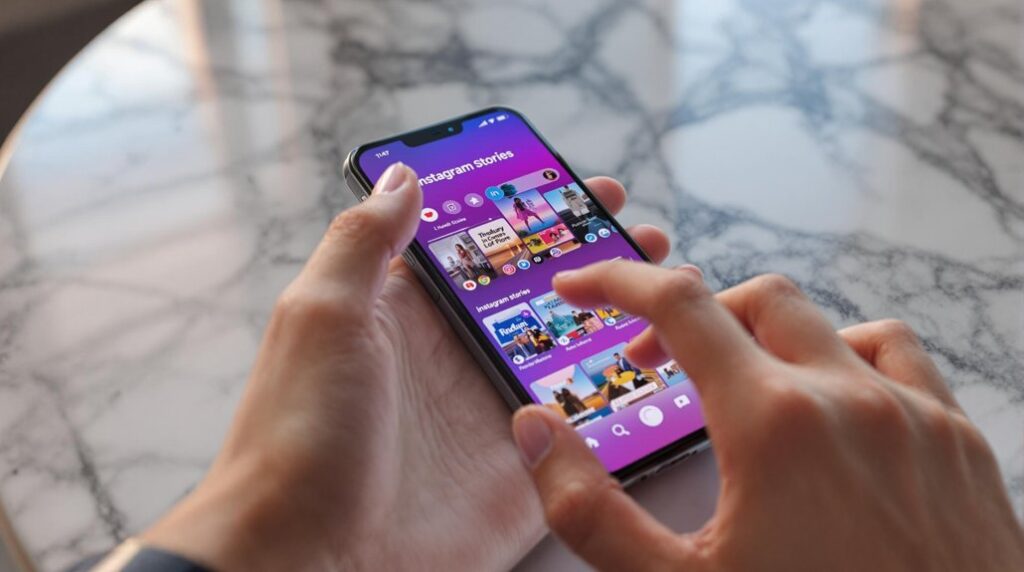Choosing between Instagram Ads and Facebook Ads depends on your business goals and target audience. Facebook Ads offer detailed audience targeting and drive strong conversions, suitable for a broad age range. Instagram Ads, on the other hand, cater to a younger, highly engaged audience with visually compelling formats. Cost-wise, Instagram is often more affordable with better engagement rates. Facebook excels in segmentation and driving sales. If you aim to boost brand visibility among digital natives, Instagram is ideal. For precise targeting and conversion, Facebook is unmatched. Understanding these nuances helps optimize your advertising strategy further.
Key Takeaways
- Instagram Ads are ideal for targeting a younger audience aged 18-34 with high engagement rates.
- Facebook Ads offer detailed audience targeting and segmentation, benefiting brands with hyper-specific audiences.
- Instagram Ads are cost-effective with CPC ranging from £0.16 to £1.64, compared to Facebook's £0.80.
- Facebook Ads excel in driving conversions and sales with extensive audience data and analytics.
- Instagram Ad formats like Stories and visual-centric content drive notable engagement and brand visibility.
Understanding Facebook Ads
Facebook ads are a strategic tool for driving traffic and conversions, thanks to their detailed audience targeting and high engagement rates. One of the standout features of Facebook ads is their ability to tap into specific audience behavior through precise targeting options. You can tailor your ads based on demographics, interests, and even purchase behavior, ensuring your message reaches the right people at the right time.
When it comes to ad performance, Facebook ads boast an average click-through rate (CTR) of 3.06%. This high engagement rate is indicative of how well these ads resonate with users. Additionally, Facebook ads are known for their low cost-per-click (CPC) and high conversion rates, making them a cost-effective option for your advertising budget.
Video feed ads on Facebook are particularly effective, offering a dynamic way to capture attention and convey your message. These ads can reach a broad audience, leveraging the platform's extensive user base.
Understanding Instagram Ads
Understanding Instagram ads involves tapping into a younger, highly engaged audience through visually compelling formats that drive notable engagement rates. Instagram stories, for instance, are particularly effective for increasing brand awareness. They typically offer lower prices and higher click-through rates compared to ads in the feed. This makes them a cost-effective option for boosting your brand's visibility.
When you invest in Instagram ads, you're leveraging a platform where brands are seeing significant ad performance improvements. The visual impact of Instagram's ad formats—whether stories, carousel ads, or videos—resonates well with users and drives higher engagement rates. By utilizing these visually rich formats, you can create more memorable and impactful ad campaigns.
Brands are increasingly allocating more of their advertising budgets to Instagram, underscoring the platform's growing popularity and effectiveness. Instagram's focus on aesthetics and visual storytelling aligns perfectly with the preferences of digital natives, making it an ideal platform to reach this demographic.
To maximize ad performance on Instagram, you should focus on creating visually compelling content that aligns with the platform's strengths. Whether through stories or feed posts, the key is to leverage Instagram's unique visual impact to capture and retain your audience's attention.
Audience Demographics
While Instagram excels in engaging younger audiences with visually compelling content, understanding the differences in audience demographics between Instagram and Facebook is key to optimizing your ad strategy. Instagram's user base skews younger, attracting a significant proportion of digital natives, particularly those aged 18-34. This age distribution makes Instagram an ideal platform if your target audience falls within this younger demographic.
Facebook, on the other hand, offers a more extensive demographic reach with its 2.96 billion monthly active users. This platform captures a broader age range, from teenagers to seniors, providing you with more diverse audience segments. If your product or service appeals to a wide age range, Facebook's detailed audience targeting options allow for precise segmentation based on buyer personas.
Geographical location is another critical factor. Both platforms have global reach, but Facebook's wider user base ensures more significant penetration in varied regions. Instagram's streamlined targeting is excellent for connecting with younger demographics in urban and digitally-savvy areas.
Cost Comparison
When comparing Instagram and Facebook ads, you'll find Instagram's CPC ranges from £0.16 to £1.64, while Facebook's is around £0.80.
Despite Instagram having a higher engagement rate (1.60% vs. Facebook's 0.09%), Facebook ads often provide better cost-effectiveness for reach and conversions.
Your budget allocation strategy should consider these nuances to maximize ROI based on your campaign goals.
Budget Allocation Efficiency
Allocating your budget efficiently between Instagram and Facebook ads hinges on understanding the cost dynamics and conversion potentials of each platform. For effective budget optimization, you need to align your marketing strategy with performance analysis and ROI tracking. Instagram story ads offer lower prices and higher click-through rates, making them excellent for brand awareness campaigns targeting a younger, engaged audience. In contrast, Facebook feed ads excel in generating traffic and conversions at a low CPC and high conversion rate.
To decide where to allocate your budget, consider the following comparison:
| Criteria | Instagram Ads | Facebook Ads |
|---|---|---|
| Cost | Lower prices, especially for story ads | Higher overall cost but effective |
| Click-Through Rate (CTR) | Higher CTR for story ads | Moderate CTR |
| Conversion Rate | Lower conversion rate | Higher conversion rate |
Brands often allocate double budgets to Instagram, yet invest more in Facebook ads due to their high conversion rates. Analyzing competitors and industry trends can further fine-tune your budget allocation. By leveraging this data, you can strategically balance your spending to maximize ROI, ensuring your marketing dollars are used effectively on both platforms.
Cost-per-Click Analysis
Comparing the cost-per-click (CPC) between Instagram and Facebook ads reveals that Instagram typically offers a more budget-friendly option for businesses looking to optimize their ad spend. The average Instagram CPC ranges from £0.16 to £1.64, whereas Facebook's stands at approximately £0.80. This disparity can greatly impact your bid strategy and overall ad relevance.
When it comes to click-through rate (CTR), Instagram often demonstrates higher engagement, translating to more clicks for a lower cost. This makes Instagram a compelling choice if you're looking to stretch your advertising budget further. However, Facebook's higher CPC comes with its own set of advantages, such as extensive reach and diverse targeting options, which can enhance ad relevance and improve conversion tracking.
Strategically, understanding these CPC variations can guide you in selecting the platform that aligns best with your objectives and budget constraints. If maximizing clicks at a lower cost is your goal, Instagram's lower CPC is advantageous.
On the other hand, if your focus is on broader reach and intricate targeting, Facebook's CPC might be worth the investment. By carefully analyzing these factors, you can make informed decisions that optimize your ad spend and drive better ROI.
Ad Formats
Understanding the diverse ad formats available on Facebook and Instagram is essential for crafting campaigns that leverage each platform's unique strengths. On Facebook, you have access to a variety of formats to match your business objectives:
- Carousel Ads: Showcase multiple images or videos within a single ad, allowing for higher image quality and engagement.
- Slideshow Ads: Create lightweight video ads from a series of still images, perfect for businesses with limited video resources.
- Collection Ads: Offer a seamless shopping experience by combining a cover image or video with multiple product images, making it easy for users to browse and purchase.
Instagram, on the other hand, emphasizes visual content. Single image or video ads are the most common, and their success relies heavily on high-quality visuals to drive engagement. Instagram Stories ads also see higher engagement rates compared to Facebook Stories, making them a powerful tool for capturing attention.
However, while Instagram ads can't include clickable links within captions, Facebook allows for longer ad copy and clickable links, enhancing click-through potential. Align your ad formats with each platform's strengths and audience behavior to achieve best outcomes.
Targeting Options
Leveraging the right targeting options on Facebook and Instagram is key to reaching your ideal audience and maximizing ad performance. Facebook offers more detailed audience targeting options compared to Instagram, making it ideal for brands with hyper-specific audiences. You can use complex targeting strategies to segment audiences based on buyer personas, interests, and behaviors.
Instagram, on the other hand, tends to attract a younger audience demographic. If your product or service aligns with this demographic, Instagram might be more effective. However, Facebook's extensive targeting capabilities, backed by robust data analytics, can help you refine your audience segmentation for more precise ad placements.
| Platform | Key Strengths |
|---|---|
| Detailed targeting options, extensive audience segmentation | |
| Younger audience demographic, visual-centric |
Consider the following when choosing your platform:
- Audience Demographics: Assess who your target audience is and where they spend their time.
- Platform Usage: Evaluate how users interact with content on each platform.
- Competitor Analysis: Research where your competitors are advertising and how they're performing.
Engagement Levels
Engagement levels on Instagram greatly overshadow those on Facebook, with an impressive engagement rate of 1.60% compared to Facebook's mere 0.09%. This disparity highlights Instagram's strength in fostering audience engagement, making it a powerhouse for brand awareness campaigns.
When evaluating where to allocate your ad budget, consider how Instagram's higher engagement can drive your objectives. Here are four key insights:
- Audience Engagement: Instagram's younger, more engaged audience responds more actively to content, boosting overall interaction rates.
- Click-through Rates: While Facebook Feed ads boast a high CTR of 4.70%, Instagram Stories, despite a lower 0.76% CTR, effectively raise brand awareness due to their immersive format.
- Brand Awareness: Instagram Stories are cost-effective, enhancing visibility without inflating your budget to a large extent.
- Conversion Rates: Although Facebook excels in conversion rates and driving sales, Instagram's high engagement can lead to better long-term customer relationships.
Strategically, if your goal is to enhance brand awareness and engage a younger audience, Instagram should be your go-to platform. However, for immediate traffic generation and conversions, Facebook's ad structure might serve you better. Balancing these platforms based on their strengths helps in adopting a well-rounded approach to your advertising strategy.
Measuring Success
To measure the success of your ad campaigns on Instagram and Facebook, begin by delving into setting clear, quantifiable goals that align with your business objectives. Define what success looks like, whether it's increasing brand awareness, driving website traffic, or boosting conversions.
Next, explore performance metrics. For Facebook feed ads, concentrate on metrics like click-through rates (CTR), conversion rates, and cost per conversion. Facebook's strength in generating traffic and conversions makes these metrics essential for evaluating direct response campaigns. Use ROI analysis to understand the return on investment for each dollar spent and compare it against your goals.
For Instagram, especially stories, prioritize metrics such as CTR and engagement rates. Given Instagram stories' effectiveness in boosting brand awareness at lower costs, you'll want to track how well your ads enhance visibility and engagement among a younger audience.
Analyzing competitor strategies and industry benchmarks can provide insights for optimization. Understand that Facebook excels in traffic generation while Instagram shines in brand awareness. Leverage these strengths to refine your ad strategy, ensuring you're maximizing ROI on both platforms.
Frequently Asked Questions
What's Better for Business Facebook or Instagram?
It depends on your goals. For higher engagement rates and targeting younger audience demographics, go with Instagram. If you need better traffic generation and conversions, Facebook's your best bet. Analyze your business objectives and choose accordingly.
Which Platform Is Best for Advertising Facebook or Instagram?
To determine which platform is best for advertising, analyze audience demographics and ad formats. Facebook feed ads drive conversions, while Instagram stories boost brand awareness among younger users. Strategically allocate your ad spend based on these insights.
Do Instagram Ads Cost More Than Facebook Ads?
When comparing costs, Instagram ads often cost more than Facebook ads. Key pricing factors include Instagram's higher average CPC and CPM. However, Instagram's increased ad spend and engagement rates might justify the higher cost for your strategy.
Are Instagram Ads Good for Business?
Yes, Instagram ads are good for business. They offer high engagement rates and strong visual appeal, especially in Stories. Strategically, they boost brand visibility and connect with a younger, more engaged audience cost-effectively.
Conclusion
Ultimately, deciding between Instagram and Facebook ads hinges on your business goals and target audience. If you're aiming for younger demographics with visually compelling content, Instagram is your go-to.
However, for broader reach and diverse ad formats, Facebook excels. Analyze engagement metrics and cost-efficiency to determine the best platform.
Strategically leveraging both could maximize your ad spend and drive superior results. Use data to stay agile and optimize your campaigns continuously.




